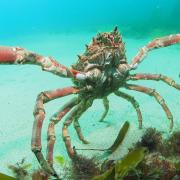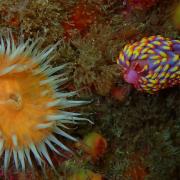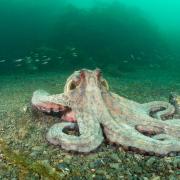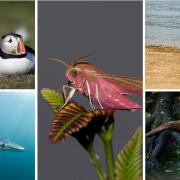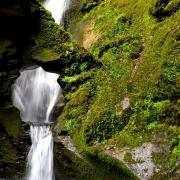In this November issue, Joana Doyle, Marine Conservation Officer at Cornwall Wildlife Trust, explains why, weather permitting, winter is a good time to spot dolphins
Winter's Water Wildlife
Joana Doyle, Marine Conservation Officer at Cornwall Wildlife Trust, explains why, weather permitting, winter is a good time to spot dolphins
Surprising though it might seem, winter is one of the best times to catch a glimpse of the dolphin, as long as the weather holds. At this time of year, pods of common dolphins often come together to form huge superpods and some of the biggest whales also pay us a visit.
Dolphins are probably the best-known group in the order Cetacea, from the Greek word cetus, meaning whale. The order includes the blue whale, the world's largest animal, dolphins, tusked narwhals, blind river dolphins and singing humpback whales — nearly 80 living species in all.
Aristotle, a Greek philosopher and natural scientist in the 4th century, was one of the first people to recognise that dolphins were not fish but mammals. For many years they were simply seen as a resource, but fortunately there now appears to be more money being made from whale-watching than whale-hunting.
That said, many species remain critically endangered, and countries such as Japan still hunt whales for 'scientific research'.
Dolphins and their ancestors have existed in our oceans for about 45 million years. Despite having adapted to a purely aquatic lifestyle, they still rely on the surface world for air. Dolphins can stay submerged far longer than humans can and this comes from their ability to use air far more efficiently. They also possess a sixth sense - echolocation. Many odontocetes (toothed cetaceans) navigate by producing sound waves using a complex system of nasal sacs and passages, and using the echoes to navigate.
These complex mammals have been using Cornish waters to feed, breed and reside in for thousands of years. Although protected within the UK, these animals still face many threats. Entanglement in fishing gear is the most common cause of mortality for the numerous dead dolphins washed up on Cornwall's beaches each year.
How to identify cetaceans
Whales and dolphins are surprisingly difficult to spot and to identify. However, with the help of binoculars, a guide book to cetaceans, a camera and a notepad, you will stand a much better chance. In general, the things to look for are its overall size, the dorsal fin size, shape and position, markings and behaviour. For the species you are most likely to encounter around Cornwall, the information below should give you a head-start on what to look out for.
Common dolphin
The common dolphin varies so much in appearance that more than 20 species have been proposed in the past but now one single species is recognised, although there are two distinct forms - the short-beaked and long-beaked. The short-beaked common dolphin is the most numerous offshore cetacean species in the temperate north-east Atlantic. The long-beaked common dolphin tends to prefer deeper waters and is observed more frequently offshore. However, they can be spotted from the coast when they come closer inshore to feed.
An adult common dolphin is about 2m long and is easily recognised by its hourglass pattern and tan or yellowish patch on each side. They have a slender, streamlined body and a tall, triangular to sickle-shaped dorsal fin, which is in the middle of the back. They are incredibly agile, often seeking out boats to bow-ride with and frequently leaping out of the water. Common dolphins are gregarious animals preferring to spend time in pods of several hundred.
Where to see: sightings are concentrated around the mouth of the Fal Estuary, the Land's End peninsula and the Isles of Scilly.
Bottlenose dolphin
Essentially a coastal dolphin, this is probably the best-known species and the one you are most likely to encounter off Cornwall. The bottlenose dolphin is a social creature often forming groups of between 2-25 individuals. Larger schools tend to occur in deeper water. The main identifying characteristics are its prominent, dark, dorsal fin, grey colour with a white belly, and playful behaviour such as body-surfing and leaping out of the water.
There are thought to be inshore and offshore forms, discernible by physical characteristics such as size and skin markings. An inshore pod of about seven bottlenose dolphins travels up and down the coast of Cornwall. There is also an offshore group, which tends to be larger and more robust.
Bottlenose dolphins have been observed feeding in a cooperative manner. Two or more dolphins from the pod encircle a shoal of fish, herding them into a small area. Other members of the pod will take turns to eat fish from the trapped shoal until all have had their share.
Where to see: localised concentrations of sightings occur in the Fal Estuary, off Penzance, around the Land's End peninsula, St Ives Bay, Newquay Bay and the Camel Estuary. At this time of year, common dolphins can form very large super-pods, sometimes numbering thousands of animals.
Harbour porpoise
The harbour porpoise is the smallest and most numerous cetacean found around Cornwall. Harbour porpoises tend to form small groups of one to three animals and are renowned for being shy creatures. They can form large aggregations but this may represent several smaller groups coming together for reasons such as feeding.
Harbour porpoises were abundant in Cornwall's estuaries, but since the 1970s they have moved away, possibly as a result of high pollution levels caused by the widespread use of organochlorines in pesticides used on the land.
Although our estuaries are now far cleaner, we have not seen the expected return of harbour porpoises. The reason for this is unclear. Much cetacean behaviour appears to be learned and perhaps the older porpoises are not teaching the younger ones to enter the estuaries, because they have never used them themselves. There may be other reasons, such as an increase in boating traffic.
Where to see: harbour porpoises are widely distributed around Cornwall, but concentrations of sightings have been observed around the Land's End peninsula and the Isles of Scilly.
Minke whale
The minke whale is the smallest (7-8.5m) and the most commonly encountered baleen whale in UK waters, ranking as the sixth most commonly sighted cetacean species around Cornwall. If you are lucky enough to spot a whale in Cornwall, chances are it will be a minke whale.
Minke whales can be recognised by their distinctive pointed snout and longitudinal ridges on their head. They have a small dorsal fin, relative to their size, which is about three-quarters of the way down their back. They have a bright white band on their pectoral fins, or flippers.
They may be confused with the fin whale, which is a similar body shape but much larger, growing to 18-22m. Fin whales have been spotted in recent years off the south coast of Cornwall during winter. Minke whales have mostly been recorded during the summer months.
Where to see: sightings have historically been concentrated around the Land's End peninsula and from further east and north, as well as from the Isles of Scilly.









